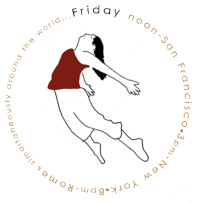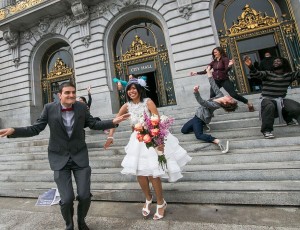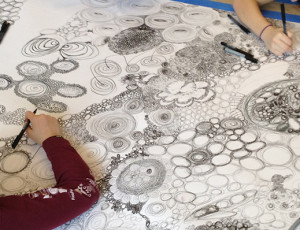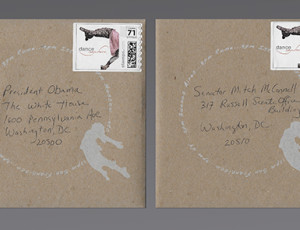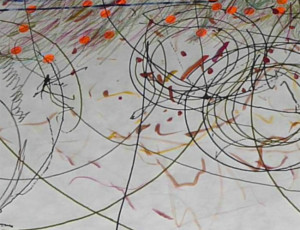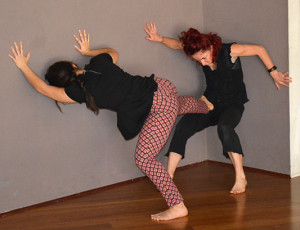
SanSan Kwan is Assistant Professor in the Theater, Dance, and Performance Studies Department at UC Berkeley. This semester she teaches an undergraduate performance theory course, Choreographies of Space: Moving Bodies and Approaches to the Production of Place, drawing upon research from her recently published book, Kinesthetic City: Dance and Movement in Chinese Urban Spaces. SanSan’s students will participate in dance anywhere® as an extra-credit component for their course.
SanSan took a moment to discuss her understandings of movement and space, her intentions for the course, and her plans to incorporate dance anywhere® into the greater scope of the class.
What compels you to teach a course on choreographies of space and where did you develop ideas for the course?
I taught this course once before, in 2010, at UC Riverside, and the impetus for teaching the course is really because a choreography of space is what the research from my first book is all about. In that book I was interested in the way that different cities move, so in other words the choreographies of those cities. I was also interested in thinking about both human and non-human movers- for example- vehicles and structures, and also bodies moving in those different cities. And I was interested in the different ways that those cities move and were choreographed, and what that might tell us about identity and community in those cities.
For this course, I was interested in exploring the way that space is choreographed by moving bodies. I was interested in this concept both historically and also cross-culturally because one of the things I am trying to demonstrate to the students in the class is the idea that there isn’t a single way to understand space. Historically, we approach space differently in different eras, at least in the realm of concert dance traditions. [In the course] we are thinking about renaissance dance and the horizontality of it, and then moving towards neo-classical dance and the height of classical ballet and how that was very much about verticality. Now we’re looking at early 20th century dance and how notions of space have changed, and then we will look at how the post-modern challenges those ideas of space all over again. But then I was also interested in, cross-culturally, how do different dance traditions think about space and approach space differently, again all with the idea of students and myself exploring the idea that space isn’t a neutral thing. Space is something that we approach with a particular set of ideas.
That was the impetus and the idea that compelled me to turn what I was thinking about for my own work into a class.
What is the name of your book?
It’s called Kinesthetic City, and it just came out last month!

Oh Really? Congratulations- I’ll have to check it out! What themes of place, space and site-specific work are you planning to study throughout the course?
We’re looking at particular eras of dance, and how space was utilized in these eras. For example, late renaissance dance, classical ballet, and early 20th century modern dance and postmodern dance. Then we’ll move to site-specific dance in the contemporary era. I also have some guest artists coming in to discuss non-western traditions. I have a Chinese traditional dance artist who will come in and talk about Chinese approaches to space and traditional Chinese dance. I’m hoping that a Brazilian artist will come in and talk about space in the Afro-Brazilian traditions. I’m also looking for someone to come in and talk about native forms of dance, and specifically someone who does California aboriginal or Polynesian native dance. I’m going to discuss Noh theater because that has a very particular approach to space too. We’re exploring these themes and ideas through more traditional classroom approaches and also through physical practice.
How does a typical class flow? What do you do for the physical practice component?
So usually reading and writing days are separate from practice days, but today we did both. I assigned some readings from Doris Humphrey’s book, The Art of Making Dances, in which she has all kinds of directives about spatial design. So we discussed the actual reading and we talked also about whether some of those ideas about spatial design resonate today. I think we determined that some do, but many don’t. And then I had the students actually do different practice, embodying some of the exercises or assignments that are in that book. That was the first day in which we did both physical practice and also discussion. Often homework assignments are movement assignments or choreographic studies of what we are discussing in class, which they then present for the class. So, for example, when we looked at late renaissance dance we did all the readings, we learned about late renaissance dance, and then I put them in groups and asked them to choreograph a dance that explores horizontal space. Whe new studied classical dance I then asked the students to take their horizontal dance and adapt it for the vertical plane. So that’s how physical practice normally works.
Have you done any work outside or in spaces around campus?
We’re going to when we get to the post-moderns because they were so interested in site-specific work. We’re going to re-stage some Simone Fortier pieces and a Trisha Brown, and those will involve going outside. I have a graduate student who writes about site-specific dance in Mexico and I don’t know quite what she’s going to have us do yet, but we may do a site-specific exploration with her, later in the semester.
How does dance anywhere® fit into the scope of your course?
When you were talking about the March 22nd event it made me think about all the YouTube dances that go viral, and the way that flash-mobs have become such a thing. We can think about flash-mobs as having their beginnings in the 1960’s/ 1970’s happenings, but then flash-mobs became these counter-cultural events and they were co-opted by organizations like T-Mobile, and now they are a phenomenon that can go in many different ways- Political or non-political, corporate or non-corporate…And then they can be viral dances, that spread quickly and rapidly, and in some ways become a way to create community across the internet, and across the world.
dance anywhere® seems to have a more hopeful and meaningful mission behind it than a viral dance video, but it might achieve the same sort of community and has a similar ability to connect people through movement and across the internet.
And how do you foresee incorporating dance anywhere® into the course?
The event doesn’t happen at the same time that the class meets, so I can’t make anybody do it, but I will encourage people to participate as an extra credit exercise. I will ask them to participate, and video it, and send a clip to me. I will also ask them to write about the experience. I would have them think particularly about what they were thinking about spatially, not only locally, in terms of their own dance, but also about the ways in which this is a worldwide, instant and simultaneous event. Thinking about time as well as physical location, because you can’t really separate space and time. dance anywhere® will be around the time in the class when we are exploring site-specific work, which is even better, because site specificity is really expanded when the idea is dance anywhere and everywhere- globally!
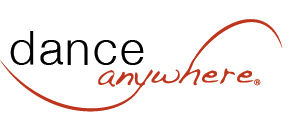
 Sign In
Sign In